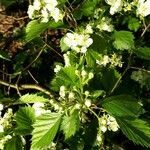Shrubs, 20–35 dm, ?sometimes clonal?. Stems: twigs: new growth usually appressed-pubescent, 1-year old usually dull yellowish to greenish brown or gray-brown to light or dark tan; thorns on twigs ?variable?, straight to slightly recurved, 1-year old shiny, dark mahogany or black, ± slender to ± stout, 3–6 cm. Leaves: petiole length 50% blade, ?usually narrowly winged distally?, pubescent, glandular young, often persisting; blade ?yellow or purplish in very dry spots (fall)?, ± rhombic to rhombic-ovate, rhombic-obovate, or ovate to broadly elliptic, ?on extension shoots similar, larger?, 2–5(–7.5) cm, thin to chartaceous, base ± cuneate, sometimes rounded to broadly ovate (at early anthesis not strikingly flabellate), lobes 2–4(–6) per side, sinuses moderately deep, lobe apex acute to subacute, margins serrate, ?teeth glands caducous, numerous, small?, veins 3–5(–7) per side, apex acute or subacute, abaxial surface glabrous, sparsely pilose-glabrescent, or villous, veins usually pubescent, adaxial appressed-scabrous, glabrescent or short-appressed-pubescent. Inflorescences 5–10-flowered, ?compact?; branches sparsely to densely villous, rarely glabrous; bracteoles ?usually hyaline?, linear, membranous, margins sessile-or short-stipitate-glandular. Flowers 15–20 mm diam.; hypanthium usually villous, sometimes glabrous; sepals triangular, 4 mm, margins glandular-serrate, ?apex subacute to obtuse, abaxially pubescent?; stamens (5–)10(or 20), anthers cream or ivory, sometimes pink; styles 3 or 4(or 5). Pomes scarlet to deep red, only darkened to burgundy if dried and shriveled (except in var. vernonensis), usually suborbicular to broadly ellipsoid or oblong, 8–10(–12) mm diam., pubescent or glabrous; sepal ?remnants present?, spreading to reflexed, ?not or rarely obscurely elevated?; pyrenes 3 or 4(or 5). 2n = 68.
More
Arborescent shrub or small tree to 7 m, with glabrous or villous, thorny twigs; lvs glabrous to strigose or short-villous on one or both sides when young, firm, dull or sometimes shiny, the veins tending to be impressed on the upper surface, the blade elliptic or suborbicular to rhombic or broadly obovate or ovate, 2–9 × 1.5–6 cm, rounded to obtuse or acutish at the tip, generally with several pairs of rather shallow lateral lobes; petiole 1/4 to 2/3 as long as the blade, glabrous or slightly glandular; fls 1.2–2 cm wide, in glabrous or slightly villous compound cymes; fr dark or bright red to rarely yellow, tending to become mellow or succulent, 0.8–1.5 cm thick, with 3–5 nutlets. Nf. and Que. to N.Y., Pa. and Va., w. to Man. and Mo., and in the Rocky Mts. (C. brunetiana; C. dodgei; C. faxonii; C. irrasa; C. jackii; C. jonesiae; C. margaretta; C. mercerensis; C. oakesiana; C. rotundifolia Moench, not Lam.)
A shrub or small tree. It grows to 6 m tall. The leaves are small and about 4 cm long. They are almost round. They are lobed and have teeth. The thorns are about 6 cm long and blackish. They are slender and straight. The flowers are 15 mm wide. They have 5 white petals. There are 5-10 pale yellow stamens. The fruit are hairy. They are 10-15 mm across. They are normally deep red. The fruit stalk is hairy.


